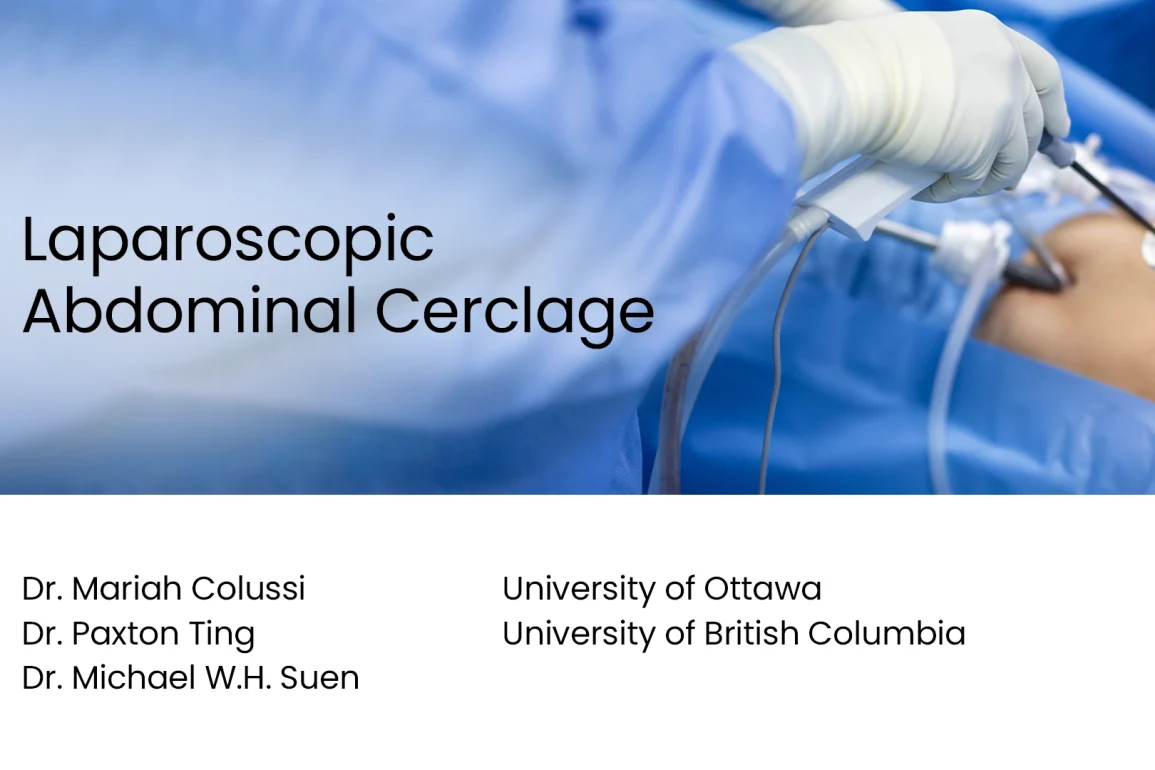Table of Contents
- Procedure Summary
- Authors
- Youtube Video
- What is Laparoscopic Abdominal Cerclage?
- What are the Risks of Laparoscopic Abdominal Cerclage?
- Video Transcript
Video Description
A step-by-step surgical video demonstrating laparoscopic abdominal cerclage for cervical insufficiency, focusing on technique, placement, and patient outcomes.
Presented By



Affiliations
University of Ottawa, University of British Columbia
Watch on YouTube
Click here to watch this video on YouTube.
What is Laparoscopic Abdominal Cerclage?
Laparoscopic abdominal cerclage is a minimally invasive procedure to prevent or treat cervical insufficiency in patients at high risk for mid-trimester pregnancy loss or preterm birth. Instead of placing a stitch through the cervix vaginally, a permanent suture or tape is positioned around the upper cervix at the level of the internal os using laparoscopy. This higher placement provides stronger support for the cervix, especially in women with a very short or damaged cervix, prior failed vaginal cerclage, or significant cervical scarring.
- Preoperative Planning: Detailed ultrasound or MRI assesses cervical length and pelvic anatomy to guide suture placement.
- Laparoscopic Access: Small abdominal ports are used to enter the pelvis and identify the uterine arteries, bladder, and cervix.
- Bladder Dissection: The bladder is gently dissected downward to expose the cervico-isthmic junction.
- Tape Placement: A permanent Mersilene tape or similar material is passed anterior to posterior around the cervix medial to the uterine vessels, then tied securely to provide circumferential support.
- Confirmation: The position of the tape is checked laparoscopically, hemostasis is confirmed, and ports are closed.
The cerclage is typically left in place for future pregnancies, allowing the patient to deliver by cesarean section.
What are the Risks of Laparoscopic Abdominal Cerclage?
Laparoscopic abdominal cerclage is generally safe but carries recognized surgical and pregnancy-related risks.
- Surgical Bleeding: Injury to the uterine vessels or surrounding pelvic vessels can lead to hemorrhage requiring transfusion or conversion to open surgery.
- Bladder or Ureteral Injury: Dissection near the bladder base and ureters places these structures at risk of trauma.
- Infection: Pelvic or port-site infection can occur despite sterile technique.
- Pregnancy Complications: Preterm labor, premature rupture of membranes, or cervical changes may still occur despite the cerclage.
- Future Delivery Limitations: Because the stitch is permanent, cesarean delivery is required for all future births.
- Anesthetic and Adhesion Risks: As with any laparoscopic procedure, there is a small risk of anesthesia-related complications and postoperative pelvic adhesions.
Careful patient selection, precise surgical technique, and ongoing obstetric follow-up help minimize these risks while providing strong and lasting cervical support.
Video Transcript:
Laparoscopic abdominal cerclage. This video will review the clinical and surgical approach for laparoscopic abdominal cerclage. There are no conflicts of interest to disclose. Throughout this video, we will review the indications for abdominal cerclage, demonstrate a surgical approach to laparoscopic abdominal cerclage, and review specific considerations during surgical planning.
Cervical insufficiency is estimated to affect nearly 1% of all pregnancies, and can lead to preterm birth, premature rupture of membranes, and, ultimately, pregnancy loss and neonatal death. Cervical insufficiency is defined as painless dilatation and shortening of the cervix before term and without labour. This is commonly identified in pregnancy as a short cervix less than 20 mm.
There are both medical and surgical options for the treatment and prevention of cervical insufficiency. McDonald and Shirodkar cerclage are placed vaginally. The McDonald cerclage is performed most commonly targeting the external os.
Open abdominal cerclage was first introduced in 1965. It has since been translated safely to a minimally invasive approach. Placement of an abdominal cerclage at the level of the cervico-isthmic junction maintains the integrity of the cervix at the level of the internal os.
There is strong literature support for the efficacy of abdominal cerclage in reduction of preterm birth and increased gestational age at delivery. Abdominal cerclage is indicated in cases of failed vaginal cerclage. It is also recommended following surgical shortening procedures such as trachelectomy or cone biopsy, and in the presence of uterine anomalies causing extreme cervical shortening.
Here, we present a minimally invasive approach to abdominal cerclage. First, placement of a uterine manipulator once cerclage is placed pre-pregnancy. Next, the vesicouterine space is developed. Third, broad ligament windows are created bilaterally and uterine vessels are identified. The cervico-isthmic junction is then identified. The cerclage is placed medial to the uterine vessels and sutured posteriorly.
After a thorough pelvic survey, the vesicouterine fold is tented upward and incised to develop a bladder flap. Peritoneal incision is extended into the broad ligament to allow for development of a broad ligament window and aid in uterine artery skeletonization. Uterine vessels are identified while creating a window in the posterior broad ligament. This window will aid in direct visualisation of suture passage.
Ureters are identified to confirm their location as away from the cervico-isthmic junction and lateral to the window. Similarly, a window is created on the contralateral side. Interestingly, the uterine artery on this side is found more cephalad than would be expected, emphasising the importance of window creation in planning suture placement.
The location of the internal os is identified posteriorly just cephalad to the insertion of the uterosacral ligaments. This insertion point is marked with a bipolar bilaterally. This is repeated anteriorly. An 0 CT-1 propylene monofilament suture is placed into the abdomen through the 10 mm umbilical port.
A 30-degree laparoscope allows for direct visualisation of the posterior insertion and anterior exit sites that were previously marked. These can be identified through the broad ligament windows. Care must be taken here to pass the suture medial to the uterine vessels without passing through the canal of the cervix.
The suture is then passed anterior to posterior on the contralateral side using the previously marked locations at the level of the internal os. When laparoscopic abdominal cerclage placement is performed preconception, a uterine manipulator is helpful to antevert and retrovert the uterus to improve ease of passing the suture. The suture is then tied intracorporeally with six knots at the posterior cervico-isthmic junction. Anti-adhesive barrier is placed at the location of the broad ligament windows to aid healing and prevent adhesion formation and bowel herniation.
We will recount the steps briefly and review specific considerations for surgical planning, including timing of placement in relation to pregnancy and specific suture selection. Again, here, we will review the steps. First, insertion of a uterine manipulator, followed by creation of a bladder flap, development of broad ligament windows, identification of the cervico-isthmic junction, and finally cerclage placement and suturing.
Here, a bladder flap has been created, and the anatomy of the broad ligament window is demonstrated. The ureter is identified through the window created in the broad ligament. This is similarly repeated on the contralateral side. A uterine manipulator during this procedure is essential to optimise the view of suture placement and identification of the cervico-isthmic junction.
During pregnancy, placement of an abdominal cerclage is associated with higher risk of reported complications, including conversion to laparotomy, haemorrhage, and bladder or bowel injury in addition to the risk of pregnancy loss.
Both polypropylene and braided polyethylene terephthalate, more commonly known as Mersilene, have been reportedly used with good efficacy for laparoscopic abdominal cerclage. Generally, a cerclage suture should be permanent and carry minimal tissue reactivity in order to minimise the risk of tissue erosion. The ease of handling of the polypropylene suture laparoscopically, in addition to the permanent and reduced tissue reactivity, make it an ideal suture material for this procedure, although there have been no head-to-head studies comparing the efficacy.
Tying the suture posteriorly allows for ease of suture removal with a posterior colpotomy in the event that the uterus requires evacuation. For example, in second trimester pregnancy loss.
In summary, laparoscopic abdominal cerclage placement is highly effective at preventing preterm birth in cases of demonstrated cervical insufficiency. It is a surgically safe procedure with low risk of complications, and it can be performed preconception and postconception, however it is safest when performed preconception or in the early first trimester. Thank you for listening to this presentation, and thank you to our collaborators.


